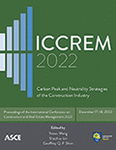Research on Local Updating of Silted Building in Tujia Nationality under the Goal of “Carbon Emissions Peak and Carbon Neutralization”
Publication: ICCREM 2022
ABSTRACT
Through partial renewal of Tujia stilted buildings, carbon emissions can be reduced in the construction and maintenance of Tujia stilted buildings, and scientific basis can be provided for the study of “carbon emission peak and carbon neutralization” countermeasures. Taking the roof of a Tujia stilted building as the research object, based on the local renewal and replacement technology, modern materials and technology are applied to the local renewal of a Tujia stilted building. The results show that (1) compared with the traditional Tujia stilted house roof, the modified roof has better water resistance, heat insulation, and green tile stability, and reduces the energy consumption and carbon emissions caused by frequent roof maintenance; (2) the integrated design of distributed photovoltaic and Tujia stilted buildings can reduce the power supply consumption of the power grid, thus transforming the consumption mode of traditional non-renewable energy. The research results can provide theoretical and reconstruction method reference for the renewal of Tujia stilted buildings and the study on the adaptability of human settlements to achieve the goal of “carbon emission peak and carbon neutralization.”
Get full access to this article
View all available purchase options and get full access to this chapter.
REFERENCES
Canada Wood China. (2021). “Vigorously developing wood structure buildings to help achieve carbon neutrality goals.” Construction Science and Technology, (20), 1. (in Chinese).
Chen, J. X., and Yang, H. Q. (2018). “Advances and frontiers in global forest and harvested wood products carbon science.” Journal of Nanjing Forestry University (Natural Science), 42(04), 1–8. (in Chinese).
Compilation Group of Brief History of Tujia Nationality. (2009). Brief history of Tujia Nationality, Nationalities Publishing House, Beijing. (in Chinese).
Dong, H. (2021). “Application of biogas and development strategy analysis in rural areas.” Gansu Agriculture, (05), 75–77. (in Chinese).
Feng, G. (2021). “Blue Book on Climate Change in China (2021).” Environment, (11), 75–77. (in Chinese).
Finnish Timber Council. (2021). “An international comparison: Wood construction meets the objectives of the climate report.” Construction Science and Technology, (18), 42–43+79-80. (in Chinese).
Gao, R., and Chen, J. (2020). “Heat-insulating mechanism and practice of the enclosure structure of the dwellings in Huizhou.” Urbanism and Architecture, 17(34), 48–51. (in Chinese).
Gong, T. X., and An, X. (2020). “A study on the techniques of building large-scale wooden works for the Tujia nationality in the west of Hubei province: Taking ‘YaoShiTou’ as an example.” Decoration, (05), 103–107. (in Chinese).
He, L. (2021). “Study on building physical strategy of wood structure in human settlements.” Liaoning Forestry Science and Technology, (02), 64–66. (in Chinese).
Lin, C. F. (2021). “Discussion on lightning-proof measures of roof distributed photovoltaic system.” China Housing Facilities, (12), 5–6. (in Chinese).
Liu, J. J., and Long, B. (2011). “Differences of stilted building from a typological perspective.” Architectural Journal, (S2), 142–147. (in Chinese).
Liu, X. L., Cui, L. L., Li, B., and Du, X. W. (2021). “Research on the high-quality development path of China’s energy industry under the target of carbon neutralization.” Journal of Beijing Institute of Technology (Social Sciences Edition), 23(03), 1–8. (in Chinese).
Liu, S., Yan, T., and Xu, X. H. (2021). “Simulation analysis of the dynamic thermal characteristics of a double-skin ventilated roof.” Building Science, 37(10), 117–121+160. (in Chinese).
Mao, M. (2020). “Study on craftsman culture of Tujia nationality’s stilted building in Xianfeng, Hubei.” Decoration, (03), 134–135. (in Chinese).
Qin, L., and Wang, X. L. (2019). “Review on the research of seismic isolation and energy dissipation technology in timber structure.” World Earthquake Engineering, 35(04), 133–140. (in Chinese).
Sun, L. P., and Cui, Z. K. (2021). “Research on development strategy of wood structure industry in China: Based on SWOT-AHP analysis.” Construction Science and Technology, (20), 45–48. (in Chinese).
Tang, J. R. (2014). “Tujia stilts building skills archival research.” Urban Construction Archives, (06), 41–42. (in Chinese).
Wang, Z. G., Shi, A., and Shao, J. H. (2021). “Study on mechanical performance of the tenon joint with through pin.” Chinese Quarterly of Mechanics, 42(03), 594–603. (in Chinese).
Xi, J. P. (2022). “Statement at the general debate of the 75th session of the United Nations general assembly.” Gazette of the State Council of the People’s Republic of China, (28), 5–7. (in Chinese).
Zhang, Y. X., Huang, L., Zhou, B. T., Xu, Y., and Chao, Q. C. (2017). “The preliminary interpretation on 1.5℃ global temperature goal.” Climate Change Research, 13(04), 299–305. (in Chinese).
Zhu, C. L. (2021). “Applications of distributed photovoltaic power generation in civil architectures.” Lamps and Lighting, (08), 73–75. (in Chinese).
Information & Authors
Information
Published In
History
Published online: Dec 15, 2022
Authors
Metrics & Citations
Metrics
Citations
Download citation
If you have the appropriate software installed, you can download article citation data to the citation manager of your choice. Simply select your manager software from the list below and click Download.
